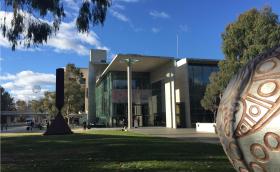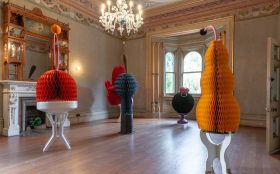One of the biggest stumbling blocks when faced with writing an artist statement is to understand its function.
Put simply, an artist statement is about information; it’s intended to bring the reader closer to the artist and their work. It is a practical and professional tool. It doesn’t have to be a complicated academic paper. And it is not about reciting someone else’s theory or philosophy.
Think of it another way: I can walk into your studio or gallery and read your work on one level. I can bring my own professional understanding to the work. But that may not always be right, what you intended, or only a fragment of the ideas you are working with. The artist statement is the moment when you can position your work – not me. It can be a very powerful professional tool.
There are many websites that offer advice on how to write an artist’s statement. There are even websites that construct text for you at the tap of a button, but are these really constructive pieces of professional writing?
Most artists find writing a statement difficult, because it often comes at a point when they are so deep in the headspace of making their work that filtering out what is necessary to include, and what is not, becomes hazy territory.
Constructing a clear sentence takes time and craft. Lucidity is no accident and writing is hard. Very few sentences come out right the first time, or event the third time. Be patient and practice.
It is part of a professional process
The accepted default position, ‘I’d rather people take away from the work what they see in it’ or ‘I’m an artist; why force me to be a writer!’, is just lazy. Almost everything we do today is navigated via words. Being able to clearly articulate your ideas is not egotistical; it is essential.
You wouldn’t think of painting a canvas without preparing it with gesso. Writing about your art is just another step in the process of making, and it flows from giving the work a title.
People who come into contact with your art – and want to know more – will have questions. The first place they will often turn is to your artist statement, to better understand what you make, and why you make it.
An artist statement can be about a body or series of work, or about your practice more generally. You will usually find an artist statement published in an exhibition catalogue or on an artist’s website. In both cases, a wordy cumbersome text quickly becomes ineffective. Kept it on point.
Read: How to write your artist bio
So lets break it down – what should you convey in your artist statement?
The seven steps to writing an artist’s statement
1. The artist statement must carry the voice of the artist. Write it in the first person – you are not some abstract concept. But don’t start every sentence, every idea with ‘I’ – you want to leave some room for the reader to connect.
2. Write it in a language that anyone can understand – not language that you only you and your friends understand, that you learned in art school. Begin with a simple statement – one strong sentence.
3. To help get you started, make a list of words and phrases that best communicate your feelings about the work and the ideas or issues that drive your art making. Answer these questions as simply as you can: Why do I make my art? Why do I use X material? What patterns, surfaces, colours emerge from the work and what feelings do they evoke? Is this influenced or inspired by anything/anyone? Why is my work different to the next artist’s? And what is the single most important thing I want to communicate through my art? Be loose. Be real.
4. But don’t be vague. If you are inspired by X then make sure X is not an abstraction, like ‘the environment’. Break that down to more specific connections that people can see and read in the work.
5. Don’t head into ‘Once upon a time’ territory. People have short attention spans, so don’t overload them with detail. An artist statement is about connecting in real time, so weight it towards the present – they don’t need an epic past. And remember this is not a session with your therapist.
6. Keep it to three to five paragraphs of three to five sentences each. Think of an inverted pyramid – you want to deliver the most important or weighty details first, so that if they only read the first paragraph, the reader will still get a sense of your practice.
7. Test it before you let it out into the world – show a friend. Do they understand what you are wanting to communicate? Eliminate any confusion. Remember, this is meant to be an effective statement that reaches out and welcomes people to your art.
Even if you are not required to write an artist statement for an exhibition, it is a very good habit to write a short paragraph about every new body of work in the studio. Practice – as with all things – helps, and inevitably you will be asked about your work. This means that you have already sorted through the ideas.
One of the hardest task an artist faces is to speak and write about their work. If you keep those words in the studio – written on a piece of paper pinned to the studio wall – then that process becomes less difficult.
It is about demystifying writing by understanding how to it connects with what is important to you. Get the key words right and the ideas in place, and the fine-tuning of the structure will follow as words and ideas find a natural order.
This story was first published on ArtsHub in 2018.






